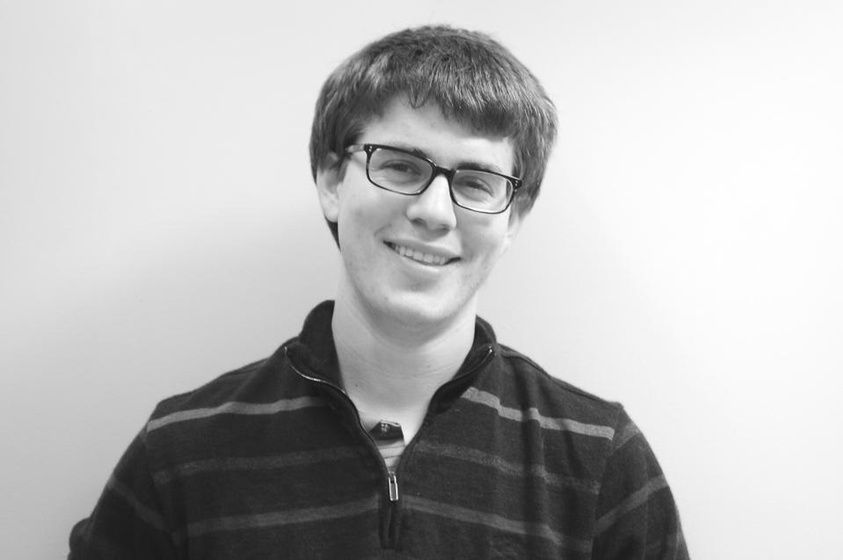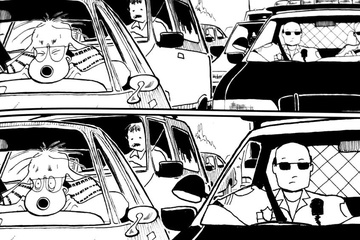Little is more American than driving and the open road. Together, they’re the nostalgic twang of country music, “Life in the Fast Lane” by the Eagles, the glory days of radio, “The Grapes of Wrath.”
Naturally, then, it came as quite a blow when I realized that I wasn’t a good driver.
Okay, perhaps that’s kind. I was a terrible driver, Godawful in fact.
It’s unclear when that truth finally dawned on me. Maybe it was on the way to my first driving test shortly after my sixteenth birthday, when I asked my mom if pushing down the turn signal meant left or right. Maybe it came after I failed my first driving test when I allegedly “ran” a red light. But I still debate that claim. Or maybe I didn’t admit I was destined for the passenger seat until I failed my second of three driving tests.
That one was actually a little more embarrassing and went something like this:
Grader: “Robert, let’s take a left turn out of the parking lot.... Okay, let’s take a right here...and another right...and another right...and right back into the parking lot.” Apparently, I had almost “hit” someone. I still swear that was a kosher driving maneuver, too.
The realization had certainly hit me by the time of my third driving test. With two embarrassing fails under my belt and driving causing far more anxiety than the SAT ever would, we found the West Covina DMV, which apparently had the highest pass rate in the state.
After waiting for 20 minutes, a middle-aged woman sporting bright red fingernails, heels, and a tight-fitting blouse strolled into my silver car and plopped herself down on the passenger seat. I wondered whether she had confused my driving test with a night out; she announced she would grade my exam. With me nervous as hell, things went fine at first until she grabbed my arm and screamed “Robert!” as I began to “turn” into a treacherous intersection’s oncoming traffic.
Yet somehow, she passed me, though only on the condition that I read an article she handed to me saying no 16 year olds should be allowed to drive. The guilt of throwing it out immediately only lasted until I turned 17.
By the time I slipped through the cracks and the Driving Gods so irresponsibly passed me, I had come to grips with my serious lack of skill and consequently made two vows: 1) I would drive as infrequently as possible, and 2) No matter what, I would avoid freeways. Too fast, too furious—why not stick to surface streets?
It’s unclear to me why my second rule came as a natural outgrowth of the first—I still have suspicions that I was incepted by my mother, ever-critical of my driving skills. Nevertheless, shortly after I became a licensed driver, the freeways were off-limits. Period. Those Steinbeckian fantasies of me (and maybe my dog) cruising the open road and soaking in America had gone the way of the Hindenburg.
By the time I graduated high school, my fear of driving had vanished. I now knew definitively that pushing down the turn signal meant you were going left. Friends no longer recited Ave Marias before stepping into my car. My mom stopped phantom breaking at every red light. But the rule regarding highways remained. Still didn’t do them, still wouldn’t do them. It had become that irrational snowball, starting as a small thought and ultimately gathering enough momentum to become an accepted truth.
In the end, I guess I still didn’t trust myself to navigate alongside 1000-pound hunks of metal flying by at warp speeds. I had tried it once, briefly, early in my driving career—five exits with an instructor to my right—and that had been quite enough, thank you.
The mental block proved as impenetrable as ever until reality kicked in after my sophomore summer, when I landed an internship downtown. After briefly running through other options (Public transportation? Difficult. Carpool? No good.), the choice became clear: I would have to take the freeway.
“Bobby, how are you going to get to work in the morning?” my mom asked as my first day approached.
“I’m going to drive.”
“Who’s going to drive?”
“I am.”
“What do you mean?”
“I’m going to drive.”
“But sweety, you don’t like driving on freeways.”
No shit.
So, before Day One, my dad and I did practice runs on the Pasadena Freeway.
A note on the Pasadena Freeway: by highway standards, it’s ancient, coming in at 70-plus years. As any sensible highway designer would, the builders worried that drivers would fall asleep on the road and so went out of their way to make it treacherously windy with non-sensical turns all over. I would have the pleasure of dealing with it twice a day.
The first few runs were iffy at best. Giving the steering wheel my death grip, I managed to navigate the turns as my dad delivered tense words and fellow drivers welcomed me to the freeway community with a friendly honk or six.
Day One to the internship came and went without a hitch: no accidents, no trauma, safely there and back. Day Two: even got comfortable enough to turn on the radio. Day Three and Day Four: knew where I was going, and perhaps survived the whole thing with only one honk.
And, as the summer went on, I even began anticipating the turns, blasting the radio, rolling the windows down, sticking my arm out the side, relinquishing my force choke on the wheel. Those high speeds which at first were prohibitive now were all part of the fun, and weekend trips to grungy (18 and up) casinos suddenly became a possibility. And so too are roadtrips to cover the football team as it travels up and down the northeast. The open road and football? Doesn’t get much more American than that.
But it’s not just these newfound skills—when and how to merge lanes, lifting the turn signal to move right—that have made the two fails and a pass worthwhile. It’s also the feeling of staring down that fear, even if it’s embodied by a woman in red nails, heels, and a tight blouse.
And as far as I’m concerned, that victory—well, that’s pretty American, too.
—Robert S. Samuels ’14, a Crimson sports chair, is an applied mathematics concentrator in Leverett House. He likes driving and dogs, but prefers smaller dogs over larger ones.



